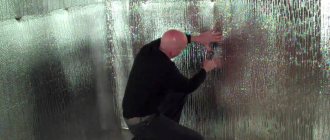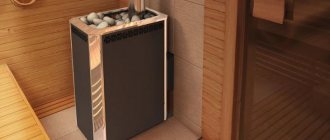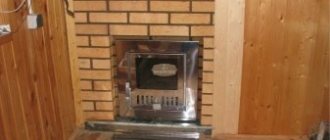Painting the outside of a log house: stages of the process
Protective and decorative painting of a house made of rounded logs on the outside is the key to its long-term preservation without loss of visual appeal. Typically, processing is divided into several stages:
- Antiseptic. Impregnation of the facade with water- or oil-based antiseptics and fire retardants disinfects the wood and prevents new insects and microorganisms from appearing (1 to 2 passes are performed). It is convenient to apply the antiseptic through a spray bottle, so a respirator and safety glasses at this stage are not superfluous. Further procedures begin after the composition has completely dried.
- Primer. The purpose of the treatment is that the composition prepares the surface for final painting. The primer prevents tree resin from escaping (in knots) and staining the paint.
The paint color is chosen taking into account the style featuresSource gomabygg.com
- Adhesive primer (acrylic or oil, optional). The impregnating composition improves the adhesion of the base paint to the wooden wall and reduces paint consumption. Avoid getting dirt and dust on the drying primer.
- Cover paint. The main paint for a log house, the final layer that decorates and protects the walls. The ideal option is acrylic paint, applied in a thin layer sequentially in three steps, using a brush or roller.
Now I turn to modern materials
I will talk about those that are intended specifically for wooden buildings.
Belinka
Professionals speak positively about the Russian manufacturer Tex. In addition to paint, the company has several types of antiseptics, including ground and glaze, drying oils, fire retardant impregnations and wax-based compounds.
Tikkurila
If finances allow, contact the Tikkurila brand, respected in Russia. The paints of this Finnish manufacturer have been tested in the harsh conditions of the northern climate. They contain components containing various additives that prevent the formation of rot, moisture absorption, and protect against ultraviolet radiation.
You can choose from acrylate paint called Pica-Techo, oil Techo, polyacrylate, Ultra-Classic. This brand, in addition to its relatively high price, has another drawback - names that are difficult to remember. Here they are.
And of course, the Finnish company has all EU certificates confirming environmental friendliness.
In general, recommendations for painting a log bathhouse boil down to what needs to be taken into account:
- Firstly: the better (that is, more famous) the manufacturer, the better and more durable its primer and topcoats;
- Secondly: use special-purpose compounds, in our case, intended for external wooden walls. If you find among well-known manufacturers special paints for facades made of rounded logs, it will be even better, but, unfortunately, I don’t know such paints.
Design
We haven’t touched on this topic before, but why not really think with you about what color to paint the bathhouse and what design options there are in general?
What color to paint
We have paints and varnishes at our disposal. The bathhouse itself is either made of wood, or lined with wood, or brick, or plastered. Perhaps it is finished with stone, for example, on the foundation.
In general, it would be desirable to maintain at least some kind of stylistic unity - at least within the bathhouse itself, and at maximum - in all buildings. That is, if you decorated the house traditionally and in natural wood colors, then painting the outside of the bathhouse pink will look... foreign. But if all the buildings on the site are bright in color, then the bathhouse should be made no less bright.
Now about the styles. We have already said once in other articles that the bathhouse has three conventional styles: tradition, high-tech and “modern” (the latter means the use of modern materials without particularly advanced design ideas).
If you choose “tradition,” then you either have timber, a log house, or lining - paint in shades from yellow through orange and reddish shades to dark brown, better with varnish than paint, so that the texture of the wood is visible.
It’s hard to believe in real “high-tech” in a summer cottage. And if it is implemented, it will be according to a design project, where all the colors will be painted.
There is only one option left - the same “conditionally modern” style, which does not have its own face. Try to “revive” it by using brighter colors. And regarding the combination of colors, we advise you to search the Internet for pictures with the phrase “color schemes” - usually this is a photograph from which several colors have been extracted (stripes under it), forming a harmonious combination. It's easier than learning color theory.
Example of color gamut extraction
Video description
Painting the lining.
If the carriage material is made of spruce, pine, aspen, linden or alder, then all of the above-mentioned coloring agents that are intended for wood can be used for painting.
Processing of lining together with holding beams Source pokraskadomov-vergiz.ru
What is special about steam room compositions?
There is only one thing: it should not release harmful substances into the air under the influence of heat. Especially when it comes to dyes that are used to paint the hottest places - the top of walls and ceilings.
Therefore, in the steam room, preference is given to impregnations rather than paints. They definitely don't emit anything when heated.
At the same time, you should not exaggerate the danger - the temperature on the floor is low, so there is no point in expecting that there will be an active release of harmful substances.
The Finns are ready to cover the floor in their sauna not only with oil emulsions, but also with urethane-alkyd compounds, and alkyd paints are generally not good for our health, at least while they dry.
So use common sense: for shelves - only impregnation, for walls and ceilings - impregnation or acrylate composition, for floors - impregnation, varnish, paint (not forgetting the undesirability of slipping).
Valuable tips for painting a log bathhouse
Let's summarize: the main goal of modern paints for timber is to protect wood from blue stains, mold, UV rays and any other atmospheric phenomena. But in order for the protective coating of the timber to do its job 100%, you must do everything correctly.
Tip #1. Paint the sauna frame yourself
If you paint a log house yourself, you will gain a lot of advantages. After all, it is quite difficult to judge the quality of the team’s work only by the appearance of the bathhouse, and their main task is to create a finished beautiful object. And, unfortunately, workers often leave unnoticeable small gaps in the processing of the log house from the outside. Over time, these places become a source of problems such as rot, mold and destruction of the walls of the bathhouse from the inside.
Tip #2. Properly prepare the log house for painting
First of all, it is important to properly prepare the surface of the log house for painting. To do this, you need to remove all dust and foreign debris.
It is advisable to rinse the bathhouse walls thoroughly with water using a hose and a stiff brush. Then dry well. If necessary, sometimes it makes sense to carry out serious grinding:
If you notice any lesions at this stage, treat them with Woodmaster Frost Whitening Solution. And for cracks and small defects Eurotex is more suitable.
Advice: if you notice traces of mold on the logs of a new bathhouse, it is advisable to consult a mycologist before painting: it is still “harmless” mold or a real destroyer.
In addition to standard cleaning and sanding of the log house, you need to take care of its protection. If you are not sure of the quality of the delivered timber, do not make do with a standard antiseptic - it is better to use Language, which kills all spores. And as a topcoat, choose a Fungicide, which will help prevent the appearance of algae and mold on the surface. In extreme cases, you need to clean the walls well and apply a clear coat of Log washadvance.
Tip #3. Paint the ends with lime or a modern equivalent
This is done in order to force water vapor to move along the log and escape through the ends. This is a natural process that occurs due to the difference in temperature indoors and outdoors, and here the steam room is at particular risk.
If in this case the park runs along the fibers, and not across, this is how moisture moves in a growing tree, well, what should you do if you have to.
Tip #4. Don't leave any gaps
During the process of painting a bathhouse, it is important to ensure that there are no unprotected gaps, which can easily cause many problems. Therefore, add a signal color to a colorless antiseptic, and then leave it to dry for 3 days during a period without rain, so that the active substances are fixed in the wood and the effect is achieved
Tip #5. Choose the most beautiful paint!
Modern manufacturers offer not only compositions that simply paint over the substrate and hide the natural grain of the wood. Today, decorative protective and decorative texture paints for log baths are in fashion, which not only preserve the wood from atmospheric agents, but emphasize its beautiful texture!
And it has additional valuable features. For example, today the following texture paints for Russian log baths are especially in fashion:
- “Favorite Dacha” is an economy-class paint to protect the log house from blue stains, ultraviolet rays, and fungus - and all this without a primer.
- “Aquatex” is a paint with an antiseptic and a modern ultraviolet filter. On the surface of the walls of a log bathhouse, it creates a semi-matte elastic coating, and also without priming. Moreover, it can be applied even to damp wood.
- The “Aquatex Extra” variety is a protective coating, an elastic coating made of natural oil and microfiber. This paint has ultraviolet protection in two ranges.
- In order to paint an old bathhouse, Aquatex Restorer paint is more suitable for you: you will be very surprised by the result.
The appearance of the bathhouse should please the eye and warm the soul!
Based on the article https://cdelayremont.ru/banya-svoimi-rukami
Impregnations and oils for the steam room or how to protect the steam room
Using a sprayer, you can quickly cover a wooden wall.
Having completed the process of interior decoration of premises with lining, you must first decide how to cover the lining in the steam room.
After all, it is here, in extreme conditions of high temperature and humidity, that the tree is most intensively exposed to harmful influences.
Color palette - to cover in the desired color
And, despite the widely held opinion that there is no need to cover the wood in the steam room with anything, prudent owners have always tried to ensure wooden walls have a long and effective lifespan.
Previously, natural remedies were used for this in the form of coating with wax or various oils: linseed, hemp, etc.
Of course, the Finns are recognized as the greatest experts in this field, who, along with the Russians, are considered the main experts and connoisseurs of the bathhouse.
As an example, here we can name well-known products from Tikkurila:
- Supi Saunasuoja is a water-based acrylic impregnation that protects against blue stains and mold. Available both colorless and tinted to obtain different shades. When choosing a color, it is better to do a test painting of a small area to evaluate the resulting shade. Apply to the surfaces of walls and ceilings with a brush or spray in two layers with an interval of 2–3 hours. If necessary, dissolve with water. Not recommended for shelves and seats. Provides coverage - 8–12 sq.m/l. Price - 310 rub./l.
- Supi Laudesuoja is an oil impregnation for benches and seats that creates a water- and dirt-proof film. Apply with a brush in one layer. Covers - 8–15 sq.m/l. Price - 1640 rub./l. During operation, the bath can be reapplied after cleaning contaminated surfaces with the following product:
- Supi Saunapesu, which disinfects, whitens, dissolves lime deposits.
From domestic materials we can recommend:
- Usadba U-409 is a protective impregnation for baths and saunas, protecting against dirt, stains and bio flora. The price of one package of 2.5 kg is 390 rubles.
- Eurotex Sauna - protective oil for coating wooden shelves in saunas. Cost - 480 rub./l. Average coverage - 12 sq. m/l.
Video - finishing the bath:
Varnishes used for processing
When deciding how to cover the lining in a bathhouse, the main thing to remember is that ordinary varnishes and paints are absolutely not suitable here.
For these purposes, there are special heat-resistant and water-resistant water-based acrylic varnishes that create a decorative polymer coating that effectively protects the wood from all harmful influences.
Evrotex Sauna is a colorless acrylic semi-matte varnish with wax and antiseptic, which creates effective protection for wood when exposed to high temperatures up to 150 C. Apply in two layers with a brush or spray with an interval of 30 minutes. Average coverage - 12 sq.m/l. The cost of packaging 2.5 kg is 490 rubles.
How to cover the board in the washing room and dressing room
In the washing room, wooden surfaces are exposed not only to water vapor, but also to the direct influence of hot water. Therefore, protecting them with antiseptics plays a primary role here. For coating, you can offer a domestic product:
To prevent fungi, you need to cover with this mixture.
SENEZH SAUNA is an antiseptic that serves to protect wooden surfaces in baths and saunas from fungi and wood-boring insects in conditions of high humidity and temperature.
It also provides hygienic antimicrobial and infection protection.
Apply 2-3 layers with a brush, roller or spray with an interval of 60 minutes. Covers an average of 10–12 square meters. m/l. The price of a 2.5 kg package is 730 rubles.
To cover the internal surfaces of bathhouses that are not in contact with the human body: walls, ceilings, doors, you can use:
Dulux Celco Sauna is a water-based thermal and moisture-proof semi-matte varnish, used at temperatures up to 120 C.
Does not fade and has no odor. In addition to wood, it can also be used for mineral surfaces such as stone, brick, concrete.
Apply with a brush, roller or spray in two layers with an interval of 2 hours. Coverage - up to 18 sq. m/l. Cost - 330 rubles/l.
The work of applying protective and decorative coatings to the internal surfaces of a bathhouse is quite within the capabilities of a home craftsman who knows how to hold painting tools in his hands.
Application
Can the floors be painted?
Can. Moreover, if we are not talking about a steam room or a washing room, you are generally not limited in your choice. But even the steam room and washing room are no exception - if you use specialized dyes or impregnations.
The floor in the steam room is the zone of least heating, and this applies even more to the sauna, because there the air flow is usually through the bottom of the entrance door, and cold air spreads along the floor, cooling it. In a Russian bath, everything is sealed to the maximum, but there and in the working area the temperature is low, so the floors have a low temperature in both cases.
We have already written about whether it is possible to paint the floors in a bathhouse with paint. However, we consider it possible to repeat that all options come down to oil impregnations (the Finns are not afraid that it will be slippery), as well as acrylate compounds (see Tikkurila products above).
In fact, if you want to paint the floor in the steam room and washing room, use the most environmentally friendly compounds - those that dissolve in water. For example, acrylic bath paints mentioned above.
Walls
There shouldn’t be any problems with this at all, because for the floor you still need to somehow select a composition with the greatest wear resistance, and for walls any composition is suitable - paints, varnishes, impregnations, any composition (preferably harmless).
How to paint stoves, boilers, tanks?
In general, it is correct that all equipment associated with heating water needs protection from corrosion, and certain paints and varnishes can help with this. You just need to figure out what exactly is suitable for these purposes.
For a metal stove
The temperature in the stove depends on the combustion temperature of the wood. Firewood comes in different types of wood and different humidity levels. Plus, another important point is air access: the more air there is, the higher the flame temperature.
Let’s assume that the combustion temperature, which varies somewhere from 500 to 1000 degrees “ideally” (that is, dry ash firewood, for example, with sufficient oxygen), in reality is 600-800 degrees (if you don’t burn it with poplar) . In this case, you should focus on paint with heat resistance of 650 degrees.
In general, either measure the temperature of the furnace with a thermometer, or somehow be guided by the color of the metal's heat (there are tables where the shade of red is converted into degrees, but, of course, it is difficult to determine the shade by eye).
In addition, there is a useful video that tells you exactly what kind of paint and how much paint you will need in your work:
For boiler
The choice of paint for your sauna boiler depends on what type of fuel you use to heat it. Coal burns at a higher temperature than wood. Ideally - at 2000 degrees, in reality - at 1000. Therefore, the boiler should be painted with paint that can withstand up to 1000 degrees.
For hot water tank
The hot water tank does not heat up above the boiling point of water. Therefore, the paint for a hot water tank in a bathhouse can be exactly the same as that used for painting radiators. Although, if there is anything left from painting the stove, you can use that too.
Lining painting techniques
The easiest way is to paint the lining before installing it on the facade. In this case, you can get a uniform layer without smudges. The paint is applied with a brush, roller or spray gun. Since the boards are quite long, the work is carried out in a spacious room or outdoors. In any case, you will need to do a little preparation.
If you decide to work indoors, you need to provide the possibility of high-quality ventilation. The floor, furniture and household items are covered with plastic film. This is especially important if you plan to use a spray gun. Don't forget about your protection. First of all, you will need cotton gloves. If the paint will be applied by spraying, wear safety glasses.
Painting lining with a paint brush
The process of applying paint is easiest if you use a quality paint brush. The best choice is semi-hard bristles, with a fairly soft and even edge. The choice of tool also depends on the amount of work. Synthetic bristle brushes are more wear-resistant.
Paint brush
The coloring technique consists of several simple steps.
Step 1. Open the container with paint and thoroughly mix the composition using any convenient device. You can use a wooden strip of sufficient length.
Step 2. Dip the brush into the paint to 1/3 of the length of the bristles.
Step 4. Lightly press the bristles onto the edge of the jar.
Step 5. Apply paint to the wood using light strokes.
Painting lining with a brush
Step 6. Repeat the process until all the boards are painted.
Do not put a lot of paint on the brush, otherwise there will be streaks
Painting the lining with your own hands
Processing lining with paint
Painting lining with a roller
Choose a narrow roller equipped with a fur coat with medium-length pile. You will need a paint tray, which is otherwise called a “paint bath” or “construction ditch.”
Paint tray, roller
Step 1 . Open the container and mix the paint.
Step 2. Pour paint into a special tray.
Step 3. Immerse the roller in the paint to ½ the height of the roller.
Step 4. Roll the roller along the corrugated beveled part of the cuvette. Thus, the paint is evenly distributed over the coat and the excess is squeezed out. One set of paint should be enough to paint 1-1.5 m2 of lining.
Putting paint on a roller
step 5. Apply paint by pressing the roller against the wood with even force.
Painting lining with a roller
Step 6. Distribute the paint so that the surface is well painted and there are no smudges on it.
Step 7: Repeat the process.
Applying paint with a roller
The lining has a rather complex profile, so the edges of the boards will have to be painted with a brush.
Gray painted paneling
Painting lining with a spray gun
An airless sprayer can be used to apply paint. This is the most successful way to carry out finishing work with an already installed facade. The spraying method allows you to paint all hard-to-reach places. But areas near window and door openings need to be refined using a paint brush.
To apply paint, you can also use devices such as low-pressure paint sprayers. When working with these tools, you need to take into account that some of the drops will settle on objects located close to the workplace. This happens because the paint exits the device’s nozzle in a fan-shaped manner. Therefore, not all particles reach the surface of the facade.
Spray painting
Working with a spray gun is more convenient than using a brush and roller. In addition, the dyeing process will be much faster.
Prices for paint sprayers
Spray gun
Painting a brick oven
Preparatory stage: If there are minor defects (depressions, bumps, potholes), first plaster and level, and cover the seams with a clay solution. You can learn how to prepare a good clay solution from the corresponding article, which is on the blog...
Plaster is made from clay and crushed asbestos. The resulting mixture is carefully applied to a well-heated stove.
How to paint: The two most popular proven folk methods are lime or chalk. The third method is again heat-resistant paint, which is also used for iron sauna stoves.
Cooking and painting with chalk
- Pour the pieces of chalk into a container (bucket, basin), fill with slightly warm water so as to cover the surface and leave for at least one hour;
- In another container, mix animal glue with warm water in a ratio of 25:1. Animal glues include gelatin, casein, albumin, and bone.
- Mix both solutions and bring to a homogeneous consistency. “To check the quality of the solution, drop it on a piece of glass or mirror placed vertically. If the density is normal, then the droplet will slide down by 2-3 cm.”
- Apply two or three layers. Each subsequent one, only after the previous one has dried. “For a more “clean” whiteness, you can add a tablespoon of blue to a bucket of the finished solution. It will remove some of the yellowness.”
Cooking and painting with lime
- Solution proportions: 1 kg of lime / 1.5 liters of water at room temperature / 1 tbsp. spoon of drying oil / 25-30 grams of blue / 1 tbsp. spoon of salt. Mix. “The most durable whitewash is made from freshly slaked lime, and salt is added to make the lime coating less dirty.”
- Apply in two or three layers. Unlike whitewashing with chalk, each subsequent layer of lime whitewash is applied to the wet previous one. “If the stove in the bathhouse was previously painted with chalk, and you intend to use lime (and vice versa), the surface must be thoroughly cleaned of old paint.”
Let's start painting
The sequence of processing walls inside and outside is the same:
- antiseptic;
- fire retardant (fire treatment);
- coloring.
The antiseptic will protect the tree from rot and prevent the proliferation of fungal spores. The fire retardant forms a film layer and contains salts that prevent fire. The paint will protect against temperature changes and moisture, and will retain the beneficial properties of the first two layers for a long time.
If the bathhouse is no longer new and the wood has changed its color, then before you start painting, you can use special wood bleaches. After using them, rinse the surfaces well, dry them and you can start painting.
Article on the topic: How to make a firewood rack in a bathhouse
Manufacturers and product prices
Bath paint is produced by domestic and foreign manufacturers. Its price depends on the material used and the quantity in the jar.
Belinka
The manufacturer's product range consists of paints, glazing compounds, varnishes, and impregnations. They have a wide range of colors, which allows you to bring any design idea to life. When using materials, the structure of the wood is preserved. Belinka produces polyacrylate paints that have water-repellent and vapor-permeable properties.
Tex
Paint from the Russian manufacturer Tex has protective qualities, which guarantees an increase in service life. The company produces soil and glaze antiseptics, drying oils, wax compositions, and fire-retardant impregnation. This allows you to choose an acceptable option for painting the bathhouse.
Tikkurila
The compositions are produced by a Finnish company in accordance with innovative developments. After production, the compositions were tested in harsh climatic conditions. The materials are developed using special components that protect the coating from ultraviolet rays and the wall from excessive absorption of moisture and rot.
The range consists of acrylate, oil and polyacrylate compounds. The paints are certified by the European Union, which ensures their environmental friendliness. The paint has a high cost, which is explained by its excellent technical characteristics. Before applying the composition, areas that cannot be painted are covered.
Saikos
The compositions of the German manufacturer are developed on the basis of natural oils and waxes. This ensures the preservation of the structure for many years.
Paint selection
For this purpose, I went to the store and purchased PINOTEX FOCUS AQUA paint 9 liters for 2,700 rubles, as well as two wide brushes.
Why this particular paint?
I didn’t really choose - I looked at the painted samples in the store, and it was this composition that seemed to me as close as possible to my understanding of the Scandinavian style. Plus the presence of wax in the paint to improve water-repellent properties and preparations to protect against mold.
9 liters should be enough for all work
The manufacturer promised complete drying of the layer in 8 hours, i.e. Over the weekend the bathhouse will be completely painted. I already had experience working independently on painting lining as a painter, so the upcoming volumes fit well into the weekend.
I took a wide brush – 100 mm
Another way to protect a sauna stove from negative influences
You don’t have to think about how to paint an iron stove in a bathhouse, since not only paint can protect it. The method of metal bluing, which involves creating a chemical reaction, is widely used.
First the surface must be cleaned. To do this, use a 5% sulfuric acid solution, which should be applied with a brush. Then the laundry soap is diluted in water in a ratio of 50 g per 1 liter. This solution must be used to wash off the previously applied sulfuric acid. Next, the oven is heated to 150-180°C and treated with caustic soda diluted in water in a ratio of 50 ml per 1 liter. The composition should be applied only by spraying to avoid splashing.
Conclusion
In order for the stove to serve for a long time, it must be well treated, and for this you should make the right choice of what to paint the stove in the bathhouse with. The solution to this issue should be taken with full responsibility and there is no need to save money, because the stove is the main component of the bathhouse.











